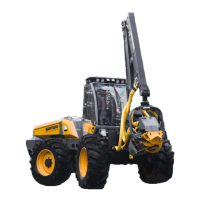Cab Fresh-air fan Provides Good
Ventilation
The 4-speed fan is started using switch H
(fig. 16). To change the airflow direction,
turn the nozzles on the panels. The fan air
is filtered in from the left-hand rear bottom
corner of the cab. The outer-most filter is of
a coarse mesh type, and the inner one is the
actual fresh air filter.
To keep up the fan capacity and secure the
purity of the air, the filters shall be cleaned
or replaced often enough to prevent impu-
rities and fungi from clogging the filters. In
dusty conditions it is necessary to clean the
coarse mesh filter several times a day.
Heater Provides Additional Heat from the Engine
The air in the cab is heated by a heating element in which the engine coolant circulates. Turn
switch G to the right to increase the amount of coolant circulating in the element. This will
increase the temperature in the cab.
Air conditioner cools the Air in the Cab
The cab can be equipped with air conditioning system.
Turn switch D fig. 16, to the right to switch on and regulate the air conditioner.
Note! A difference of over 8°C between indoor and outdoor temperature is harmful to your
health.
Keep the cab door closed when the air-conditioning is on. Keep the heater regulator lever in
its cold position, i.e. the heater water circulation off.
Working lights
You can select the number of the working lights that are on using the working light switches
on the instrument panel (figure 2, switches J, K and L). For the working lights controlled by
switch J, it is possible to use a so-called delayed light function by leaving these lights on
before turning the main power switch off. Some of the harvester’s working lights remain on
to light the surroundings while you leave the harvester. The lights switch off on their own
in about 90 seconds. The switch R (figure 2) controls the working light inside the engine
compartment. It should only be used during service operations.

